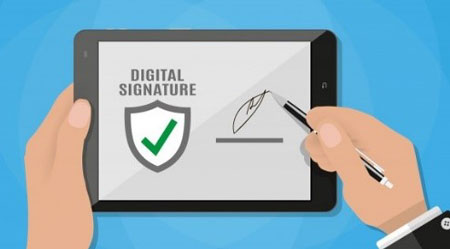Understanding digital and electronic signatures

TECHNOLOGY
The use of electronic signatures has skyrocketed in the last few years. It is now commonplace in many banking, real estate and legal transactions. As the software has evolved, it has also become much more accessible. Many small organizations can now easily implement and use this secure and efficient function.
What is the difference between digital and electronic signatures?
As the digitization of documents, processes and messaging continues, just like someone physically signing a contract, a trustworthy mechanism to determine and capture the signer’s intent is required. The terms “electronic signature” and “digital signature” are often used interchangeably to describe this intent. However, there are important differences.
- The term “electronic signature” or “e-signature” represents the broader concept, as it simply refers to the signature data being in electronic form.
- By contrast, a digital signature ensures the validity of digital messages and documents. Key to this validation is ensuring sender authentication (the sender is known) as well as the providing a level of assurance that the document’s integrity has not been altered while in transit. A mathematical schema is used (think of this as encryption), with a set of accepted standards to provide a high level of security and trust.
In short: A digital signature can be an electronic signature, but the reverse is not always true.
Why would you want to use a digital signature?
Electronic signatures provide several important advantages:
- Lower cost: Businesses save on the cost of paper, postage and – most importantly – time. These enhancements are also much more environmentally friendly.
- Simple and convenient to use: With most electronic signature software, you simply assign your designated signatories and their email address. The documents are distributed electronically, so your signatories can be spread out around the world and receive your document immediately.
- Fast turnaround: Without having to wait for regular delivery, or to arrange an in-person meeting, you can have your documents distributed, signed and returned in a fraction of the time required by the traditional method. Such a process can also be fit into a corporate workflow to further speed up the process.
- Highly secure: Given all the protocols in place with digital signatures, they are actually more secure than a traditional physical signature. The digital signature contains an electronic history of who signed the document, where they where and when the signature was executed.
There are some important aspects of electronic signatures that can limit how you use this functionality. As stated above, digital signatures add a high degree of security. However, not all security is created equal. Be sure to research the security aspects of the electronic signature software you are evaluating or using. Also be sure to investigate how your documents are stored by the software, and whether you can still access them if you stop paying for (or licensing) the software. Some providers use proprietary applications where, without an active account with them, you may lose access to your own material.
How does a digital signature work?
As mentioned earlier, digital signatures utilize specific protocols that are assigned to each individual involved. This protocol is called the public key infrastructure (PKI). When a signature is created, two keys are generated: one kept private by the initiator and one that is public. The mathematical mechanism of the software translates these keys as needed, encrypts them and associates the public key with the document to be signed. The resulting encrypted data is what is referred to as the “digital signature.” It contains the encrypted details of who signed the document, when and where. A certificate authority (CA) is an entity that certifies the ownership of public keys, providing assurance of the integrity of the digital signature and ensuring that the digital signatures are reliably created and saved. This encryption, integrity and reliability are the key services of the software provider you are paying for.
What should you look for in an electronic signature tool?
When selecting an electronic signature platform, there are some key aspects to investigate. These items should be well understood, as they affect how you will use the software and mitigate future issues.
- As previously mentioned, be sure to understand the security protocols that the software provides. Ensure that it comes from a reliable and reputable provider that encrypts both the data and the traffic.
- Ensure that the signature software integrates well with the other applications that you currently use. The software should work with applications like your Adobe Acrobat, Microsoft Word, Google Docs or other applications that you will be using to generate your documents.
- Document storage solutions should be robust and offer flexibility. Ensure that you can access your documents even after you stop using that specific signature software.
- Assess whether you require other functions like status tracking, alert definitions and role management (signers, read-only, etc.), and whether multiple users need to access the same document at the same time or on various devices.
Whether your need is to improve efficiency in getting documents signed or to improve document traceability, or you simply want to be more environmentally friendly, electronic signatures offer a great option. Just do a little homework on what provider best fits your needs, and rest assured that electronic signatures offer a secure and recognized alternative to your John Hancock.
Disclaimer
The information provided on this page is intended to provide general information. The information does not take into account your personal situation and is not intended to be used without consultation from accounting and financial professionals. Allan Madan and Madan Chartered Accountant will not be held liable for any problems that arise from the usage of the information provided on this page.


SOCIAL CONNECT